Exercise & Diabetes: Lifestyle Interventions and Clinical Practice
VerifiedAdded on 2023/04/21
|22
|5995
|249
Literature Review
AI Summary
This paper provides a comprehensive literature review on the efficacy of exercise and lifestyle interventions in managing diabetes, particularly within Asian populations at high risk of developing type 2 diabetes (T2D). It begins by establishing the background and significance of the issue, noting the increasing prevalence of diabetes and its socio-economic impact, especially in Asia. The methodology section details the systematic approach used to gather relevant articles from databases like PubMed and CINAHL, employing specific inclusion and exclusion criteria. The discussion section synthesizes findings from selected studies, highlighting the effects of lifestyle interventions on weight reduction, diabetes management, and metabolic profiles. It further critically analyzes the alignment of these interventions with NHS domains, identifying clinical gaps and offering recommendations for improvement. Ultimately, the review underscores the importance of non-pharmacological interventions, such as diet and exercise, in reducing the risk and impact of diabetes, while also acknowledging challenges in adherence and implementation.
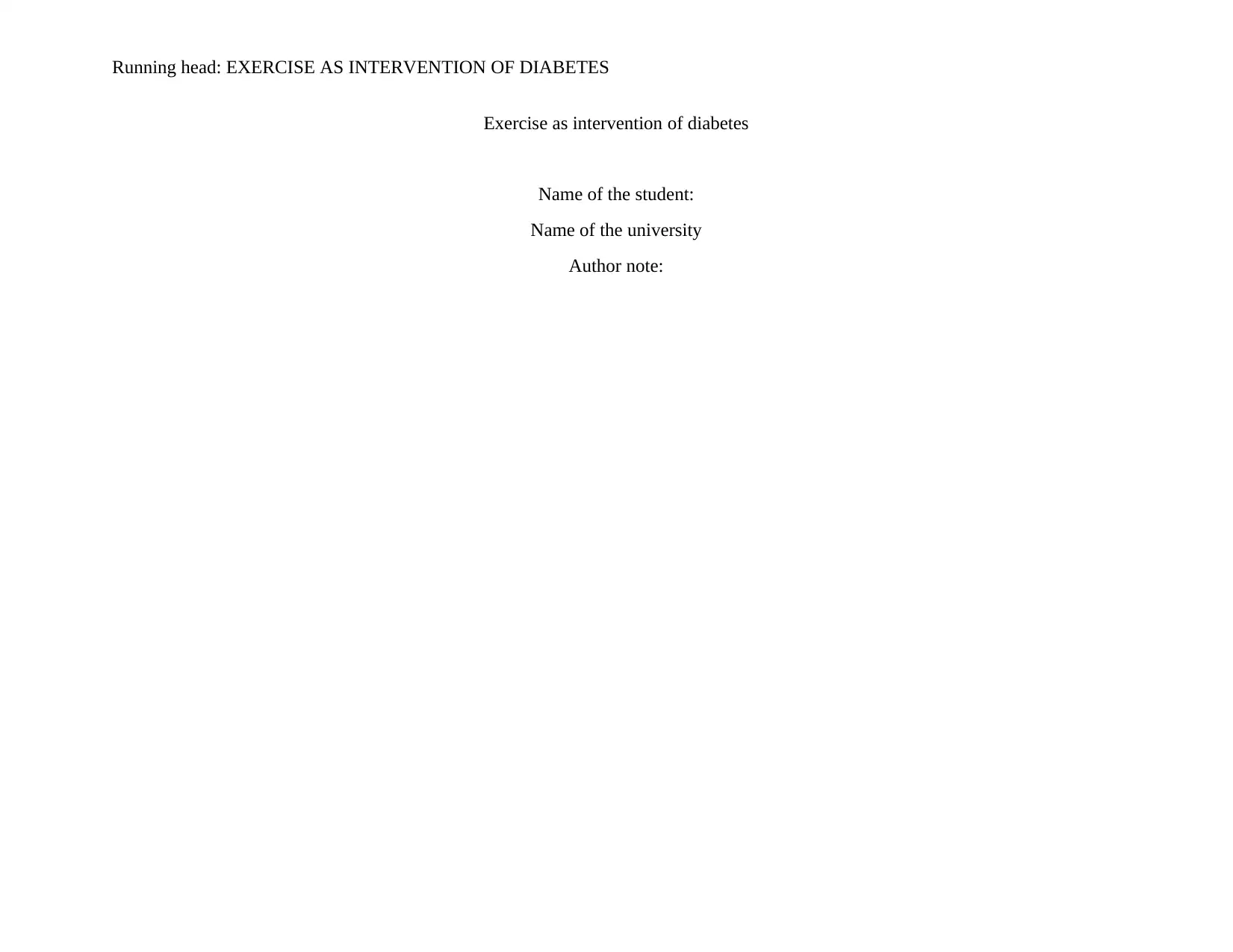
Running head: EXERCISE AS INTERVENTION OF DIABETES
Exercise as intervention of diabetes
Name of the student:
Name of the university
Author note:
Exercise as intervention of diabetes
Name of the student:
Name of the university
Author note:
Paraphrase This Document
Need a fresh take? Get an instant paraphrase of this document with our AI Paraphraser
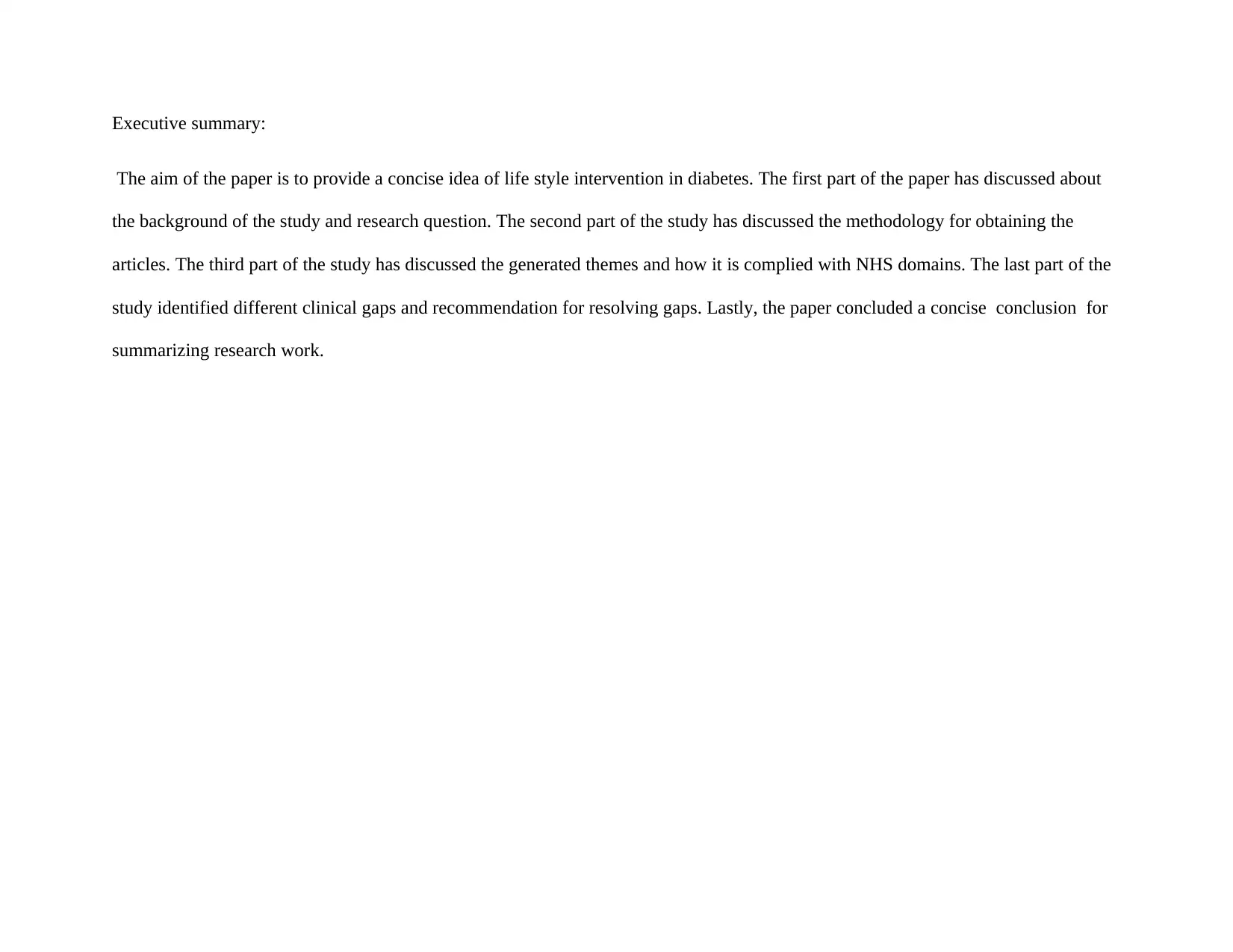
Executive summary:
The aim of the paper is to provide a concise idea of life style intervention in diabetes. The first part of the paper has discussed about
the background of the study and research question. The second part of the study has discussed the methodology for obtaining the
articles. The third part of the study has discussed the generated themes and how it is complied with NHS domains. The last part of the
study identified different clinical gaps and recommendation for resolving gaps. Lastly, the paper concluded a concise conclusion for
summarizing research work.
The aim of the paper is to provide a concise idea of life style intervention in diabetes. The first part of the paper has discussed about
the background of the study and research question. The second part of the study has discussed the methodology for obtaining the
articles. The third part of the study has discussed the generated themes and how it is complied with NHS domains. The last part of the
study identified different clinical gaps and recommendation for resolving gaps. Lastly, the paper concluded a concise conclusion for
summarizing research work.
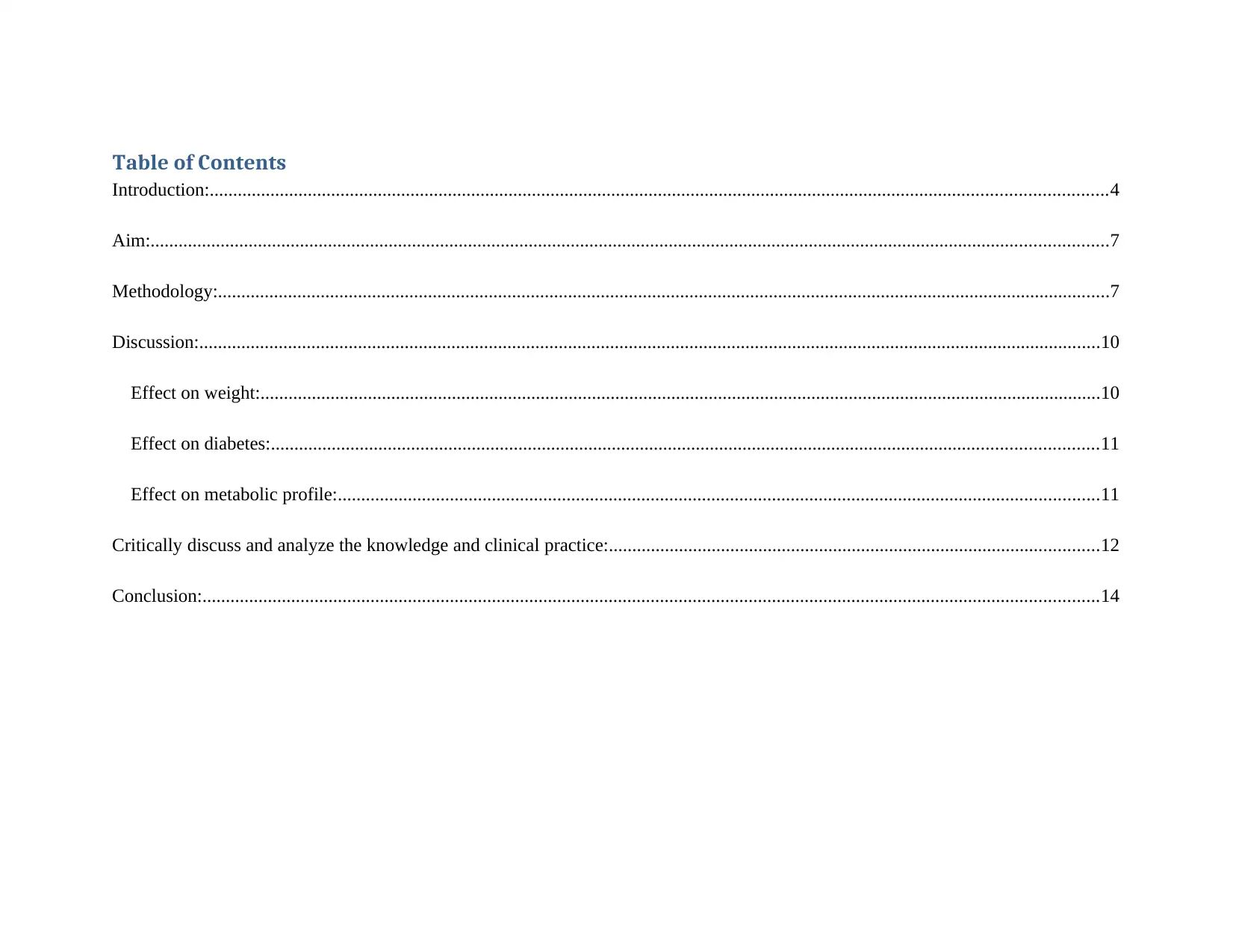
Table of Contents
Introduction:................................................................................................................................................................................................4
Aim:.............................................................................................................................................................................................................7
Methodology:...............................................................................................................................................................................................7
Discussion:.................................................................................................................................................................................................10
Effect on weight:....................................................................................................................................................................................10
Effect on diabetes:.................................................................................................................................................................................11
Effect on metabolic profile:...................................................................................................................................................................11
Critically discuss and analyze the knowledge and clinical practice:.........................................................................................................12
Conclusion:................................................................................................................................................................................................14
Introduction:................................................................................................................................................................................................4
Aim:.............................................................................................................................................................................................................7
Methodology:...............................................................................................................................................................................................7
Discussion:.................................................................................................................................................................................................10
Effect on weight:....................................................................................................................................................................................10
Effect on diabetes:.................................................................................................................................................................................11
Effect on metabolic profile:...................................................................................................................................................................11
Critically discuss and analyze the knowledge and clinical practice:.........................................................................................................12
Conclusion:................................................................................................................................................................................................14
⊘ This is a preview!⊘
Do you want full access?
Subscribe today to unlock all pages.

Trusted by 1+ million students worldwide
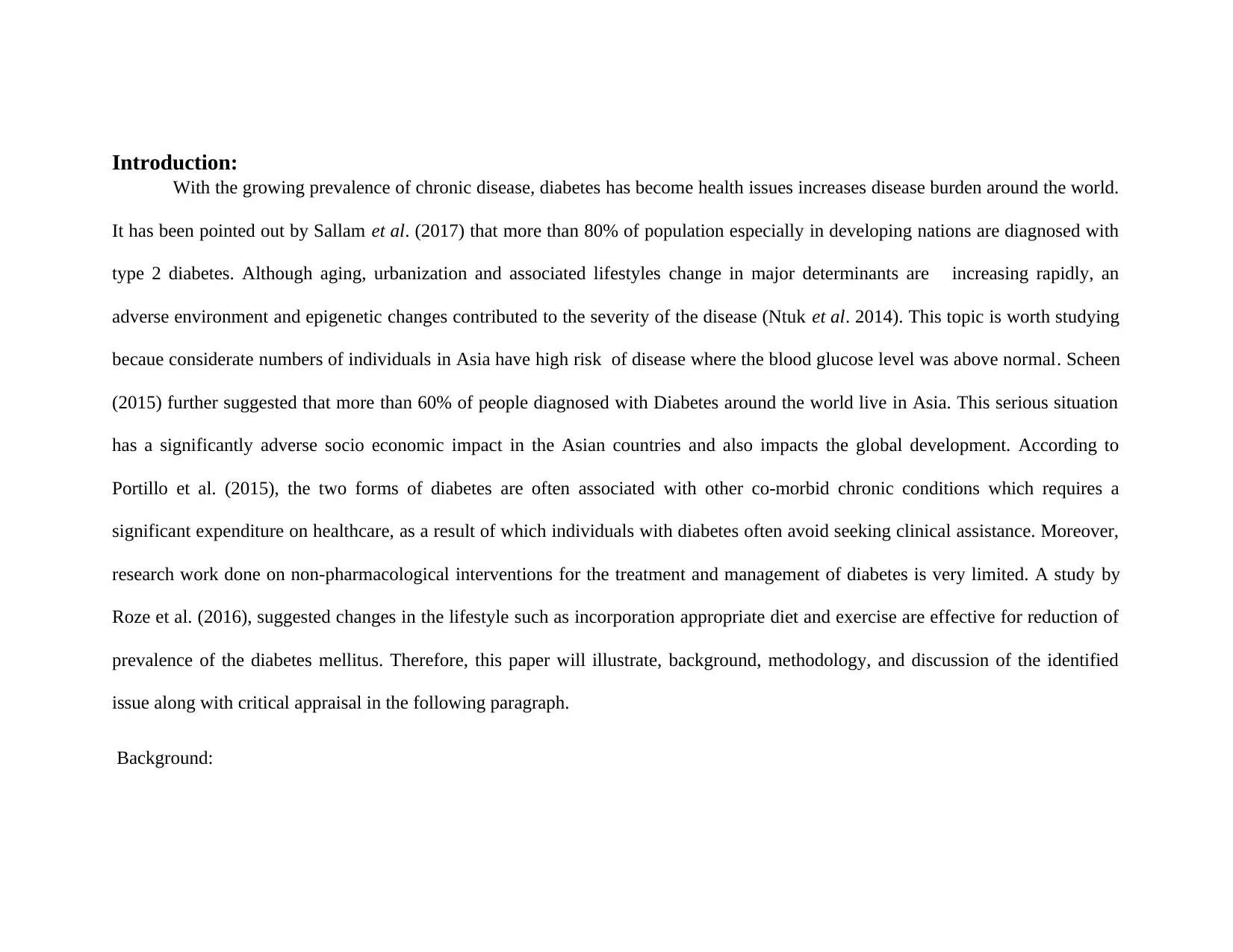
Introduction:
With the growing prevalence of chronic disease, diabetes has become health issues increases disease burden around the world.
It has been pointed out by Sallam et al. (2017) that more than 80% of population especially in developing nations are diagnosed with
type 2 diabetes. Although aging, urbanization and associated lifestyles change in major determinants are increasing rapidly, an
adverse environment and epigenetic changes contributed to the severity of the disease (Ntuk et al. 2014). This topic is worth studying
becaue considerate numbers of individuals in Asia have high risk of disease where the blood glucose level was above normal. Scheen
(2015) further suggested that more than 60% of people diagnosed with Diabetes around the world live in Asia. This serious situation
has a significantly adverse socio economic impact in the Asian countries and also impacts the global development. According to
Portillo et al. (2015), the two forms of diabetes are often associated with other co-morbid chronic conditions which requires a
significant expenditure on healthcare, as a result of which individuals with diabetes often avoid seeking clinical assistance. Moreover,
research work done on non-pharmacological interventions for the treatment and management of diabetes is very limited. A study by
Roze et al. (2016), suggested changes in the lifestyle such as incorporation appropriate diet and exercise are effective for reduction of
prevalence of the diabetes mellitus. Therefore, this paper will illustrate, background, methodology, and discussion of the identified
issue along with critical appraisal in the following paragraph.
Background:
With the growing prevalence of chronic disease, diabetes has become health issues increases disease burden around the world.
It has been pointed out by Sallam et al. (2017) that more than 80% of population especially in developing nations are diagnosed with
type 2 diabetes. Although aging, urbanization and associated lifestyles change in major determinants are increasing rapidly, an
adverse environment and epigenetic changes contributed to the severity of the disease (Ntuk et al. 2014). This topic is worth studying
becaue considerate numbers of individuals in Asia have high risk of disease where the blood glucose level was above normal. Scheen
(2015) further suggested that more than 60% of people diagnosed with Diabetes around the world live in Asia. This serious situation
has a significantly adverse socio economic impact in the Asian countries and also impacts the global development. According to
Portillo et al. (2015), the two forms of diabetes are often associated with other co-morbid chronic conditions which requires a
significant expenditure on healthcare, as a result of which individuals with diabetes often avoid seeking clinical assistance. Moreover,
research work done on non-pharmacological interventions for the treatment and management of diabetes is very limited. A study by
Roze et al. (2016), suggested changes in the lifestyle such as incorporation appropriate diet and exercise are effective for reduction of
prevalence of the diabetes mellitus. Therefore, this paper will illustrate, background, methodology, and discussion of the identified
issue along with critical appraisal in the following paragraph.
Background:
Paraphrase This Document
Need a fresh take? Get an instant paraphrase of this document with our AI Paraphraser
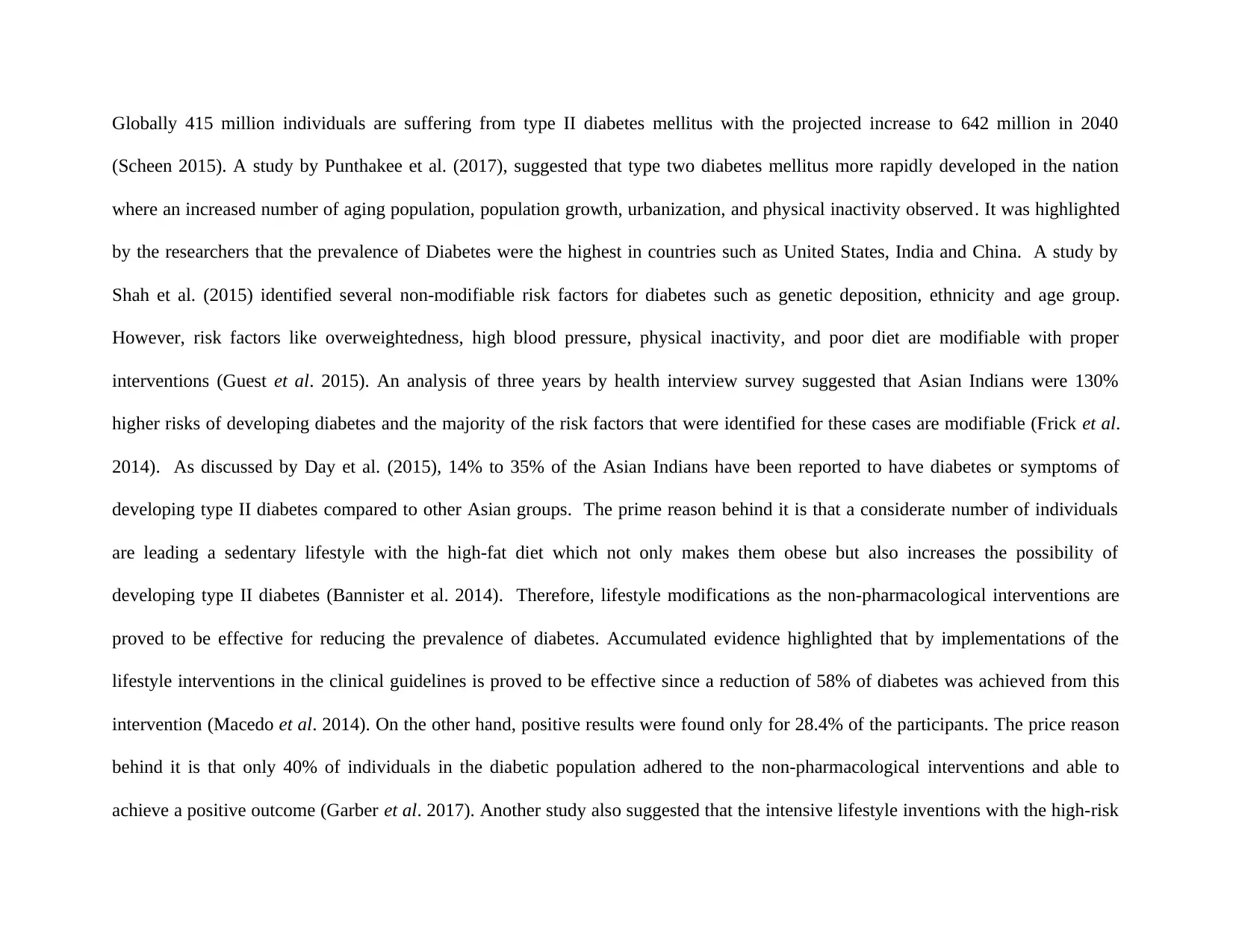
Globally 415 million individuals are suffering from type II diabetes mellitus with the projected increase to 642 million in 2040
(Scheen 2015). A study by Punthakee et al. (2017), suggested that type two diabetes mellitus more rapidly developed in the nation
where an increased number of aging population, population growth, urbanization, and physical inactivity observed. It was highlighted
by the researchers that the prevalence of Diabetes were the highest in countries such as United States, India and China. A study by
Shah et al. (2015) identified several non-modifiable risk factors for diabetes such as genetic deposition, ethnicity and age group.
However, risk factors like overweightedness, high blood pressure, physical inactivity, and poor diet are modifiable with proper
interventions (Guest et al. 2015). An analysis of three years by health interview survey suggested that Asian Indians were 130%
higher risks of developing diabetes and the majority of the risk factors that were identified for these cases are modifiable (Frick et al.
2014). As discussed by Day et al. (2015), 14% to 35% of the Asian Indians have been reported to have diabetes or symptoms of
developing type II diabetes compared to other Asian groups. The prime reason behind it is that a considerate number of individuals
are leading a sedentary lifestyle with the high-fat diet which not only makes them obese but also increases the possibility of
developing type II diabetes (Bannister et al. 2014). Therefore, lifestyle modifications as the non-pharmacological interventions are
proved to be effective for reducing the prevalence of diabetes. Accumulated evidence highlighted that by implementations of the
lifestyle interventions in the clinical guidelines is proved to be effective since a reduction of 58% of diabetes was achieved from this
intervention (Macedo et al. 2014). On the other hand, positive results were found only for 28.4% of the participants. The price reason
behind it is that only 40% of individuals in the diabetic population adhered to the non-pharmacological interventions and able to
achieve a positive outcome (Garber et al. 2017). Another study also suggested that the intensive lifestyle inventions with the high-risk
(Scheen 2015). A study by Punthakee et al. (2017), suggested that type two diabetes mellitus more rapidly developed in the nation
where an increased number of aging population, population growth, urbanization, and physical inactivity observed. It was highlighted
by the researchers that the prevalence of Diabetes were the highest in countries such as United States, India and China. A study by
Shah et al. (2015) identified several non-modifiable risk factors for diabetes such as genetic deposition, ethnicity and age group.
However, risk factors like overweightedness, high blood pressure, physical inactivity, and poor diet are modifiable with proper
interventions (Guest et al. 2015). An analysis of three years by health interview survey suggested that Asian Indians were 130%
higher risks of developing diabetes and the majority of the risk factors that were identified for these cases are modifiable (Frick et al.
2014). As discussed by Day et al. (2015), 14% to 35% of the Asian Indians have been reported to have diabetes or symptoms of
developing type II diabetes compared to other Asian groups. The prime reason behind it is that a considerate number of individuals
are leading a sedentary lifestyle with the high-fat diet which not only makes them obese but also increases the possibility of
developing type II diabetes (Bannister et al. 2014). Therefore, lifestyle modifications as the non-pharmacological interventions are
proved to be effective for reducing the prevalence of diabetes. Accumulated evidence highlighted that by implementations of the
lifestyle interventions in the clinical guidelines is proved to be effective since a reduction of 58% of diabetes was achieved from this
intervention (Macedo et al. 2014). On the other hand, positive results were found only for 28.4% of the participants. The price reason
behind it is that only 40% of individuals in the diabetic population adhered to the non-pharmacological interventions and able to
achieve a positive outcome (Garber et al. 2017). Another study also suggested that the intensive lifestyle inventions with the high-risk
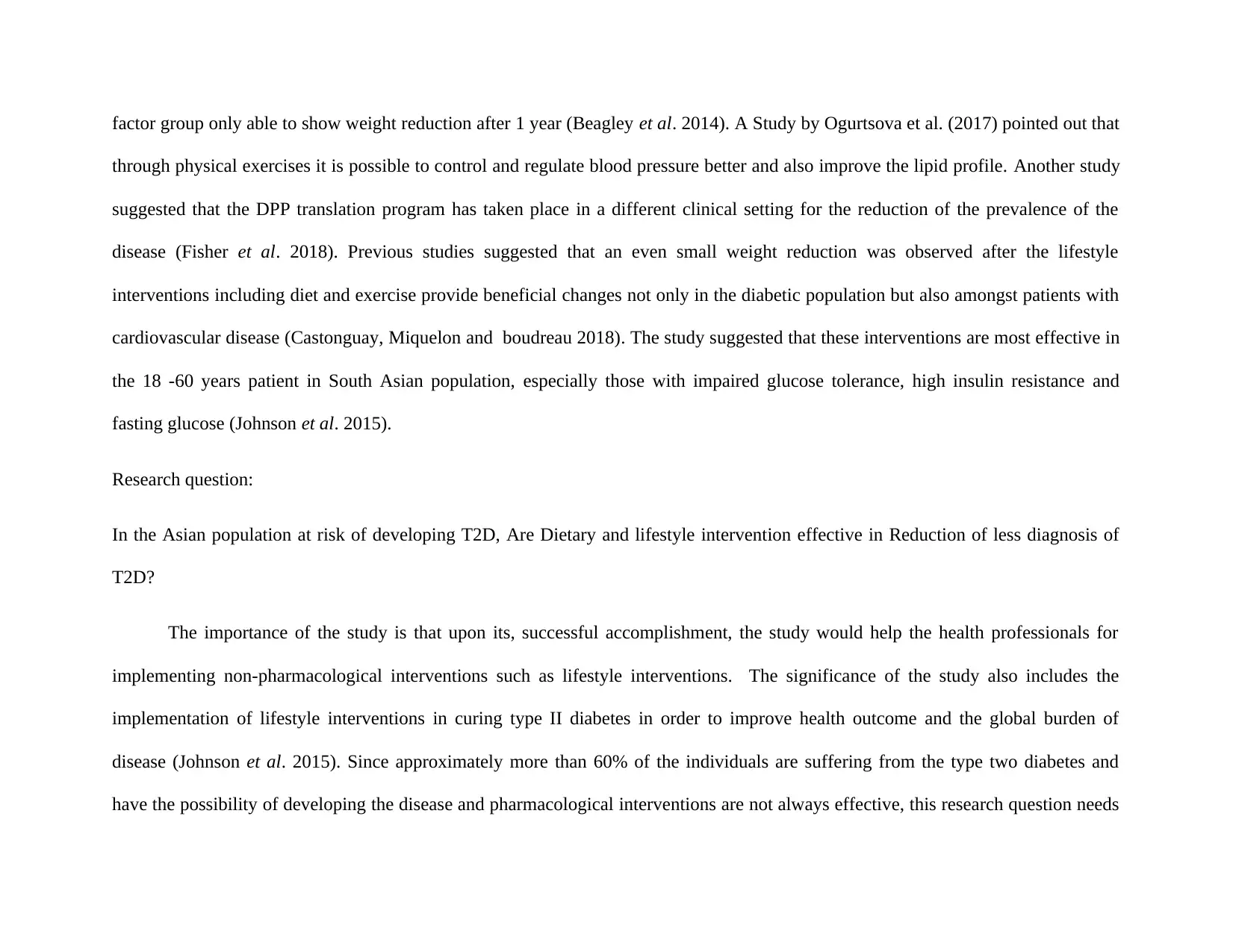
factor group only able to show weight reduction after 1 year (Beagley et al. 2014). A Study by Ogurtsova et al. (2017) pointed out that
through physical exercises it is possible to control and regulate blood pressure better and also improve the lipid profile. Another study
suggested that the DPP translation program has taken place in a different clinical setting for the reduction of the prevalence of the
disease (Fisher et al. 2018). Previous studies suggested that an even small weight reduction was observed after the lifestyle
interventions including diet and exercise provide beneficial changes not only in the diabetic population but also amongst patients with
cardiovascular disease (Castonguay, Miquelon and boudreau 2018). The study suggested that these interventions are most effective in
the 18 -60 years patient in South Asian population, especially those with impaired glucose tolerance, high insulin resistance and
fasting glucose (Johnson et al. 2015).
Research question:
In the Asian population at risk of developing T2D, Are Dietary and lifestyle intervention effective in Reduction of less diagnosis of
T2D?
The importance of the study is that upon its, successful accomplishment, the study would help the health professionals for
implementing non-pharmacological interventions such as lifestyle interventions. The significance of the study also includes the
implementation of lifestyle interventions in curing type II diabetes in order to improve health outcome and the global burden of
disease (Johnson et al. 2015). Since approximately more than 60% of the individuals are suffering from the type two diabetes and
have the possibility of developing the disease and pharmacological interventions are not always effective, this research question needs
through physical exercises it is possible to control and regulate blood pressure better and also improve the lipid profile. Another study
suggested that the DPP translation program has taken place in a different clinical setting for the reduction of the prevalence of the
disease (Fisher et al. 2018). Previous studies suggested that an even small weight reduction was observed after the lifestyle
interventions including diet and exercise provide beneficial changes not only in the diabetic population but also amongst patients with
cardiovascular disease (Castonguay, Miquelon and boudreau 2018). The study suggested that these interventions are most effective in
the 18 -60 years patient in South Asian population, especially those with impaired glucose tolerance, high insulin resistance and
fasting glucose (Johnson et al. 2015).
Research question:
In the Asian population at risk of developing T2D, Are Dietary and lifestyle intervention effective in Reduction of less diagnosis of
T2D?
The importance of the study is that upon its, successful accomplishment, the study would help the health professionals for
implementing non-pharmacological interventions such as lifestyle interventions. The significance of the study also includes the
implementation of lifestyle interventions in curing type II diabetes in order to improve health outcome and the global burden of
disease (Johnson et al. 2015). Since approximately more than 60% of the individuals are suffering from the type two diabetes and
have the possibility of developing the disease and pharmacological interventions are not always effective, this research question needs
⊘ This is a preview!⊘
Do you want full access?
Subscribe today to unlock all pages.

Trusted by 1+ million students worldwide
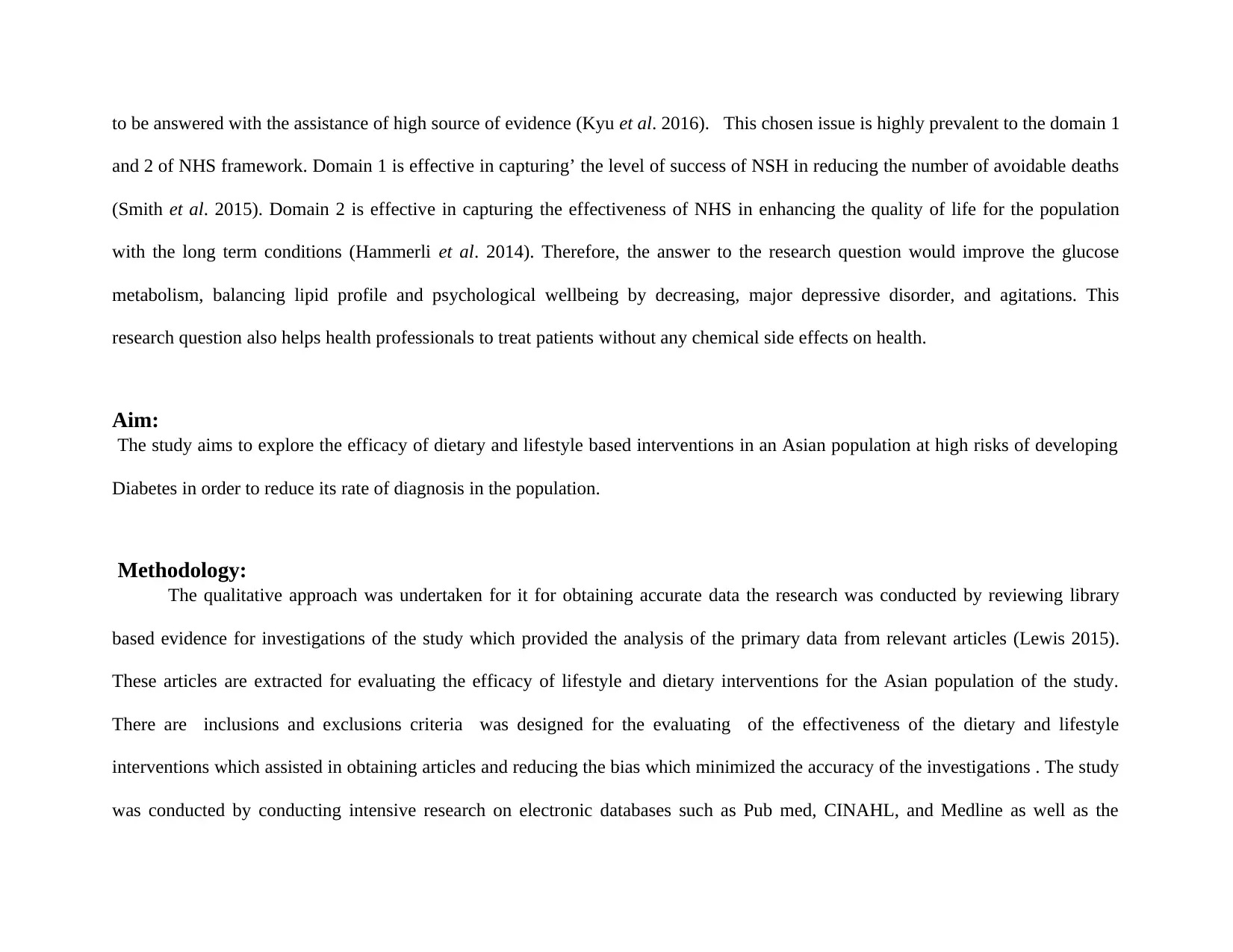
to be answered with the assistance of high source of evidence (Kyu et al. 2016). This chosen issue is highly prevalent to the domain 1
and 2 of NHS framework. Domain 1 is effective in capturing’ the level of success of NSH in reducing the number of avoidable deaths
(Smith et al. 2015). Domain 2 is effective in capturing the effectiveness of NHS in enhancing the quality of life for the population
with the long term conditions (Hammerli et al. 2014). Therefore, the answer to the research question would improve the glucose
metabolism, balancing lipid profile and psychological wellbeing by decreasing, major depressive disorder, and agitations. This
research question also helps health professionals to treat patients without any chemical side effects on health.
Aim:
The study aims to explore the efficacy of dietary and lifestyle based interventions in an Asian population at high risks of developing
Diabetes in order to reduce its rate of diagnosis in the population.
Methodology:
The qualitative approach was undertaken for it for obtaining accurate data the research was conducted by reviewing library
based evidence for investigations of the study which provided the analysis of the primary data from relevant articles (Lewis 2015).
These articles are extracted for evaluating the efficacy of lifestyle and dietary interventions for the Asian population of the study.
There are inclusions and exclusions criteria was designed for the evaluating of the effectiveness of the dietary and lifestyle
interventions which assisted in obtaining articles and reducing the bias which minimized the accuracy of the investigations . The study
was conducted by conducting intensive research on electronic databases such as Pub med, CINAHL, and Medline as well as the
and 2 of NHS framework. Domain 1 is effective in capturing’ the level of success of NSH in reducing the number of avoidable deaths
(Smith et al. 2015). Domain 2 is effective in capturing the effectiveness of NHS in enhancing the quality of life for the population
with the long term conditions (Hammerli et al. 2014). Therefore, the answer to the research question would improve the glucose
metabolism, balancing lipid profile and psychological wellbeing by decreasing, major depressive disorder, and agitations. This
research question also helps health professionals to treat patients without any chemical side effects on health.
Aim:
The study aims to explore the efficacy of dietary and lifestyle based interventions in an Asian population at high risks of developing
Diabetes in order to reduce its rate of diagnosis in the population.
Methodology:
The qualitative approach was undertaken for it for obtaining accurate data the research was conducted by reviewing library
based evidence for investigations of the study which provided the analysis of the primary data from relevant articles (Lewis 2015).
These articles are extracted for evaluating the efficacy of lifestyle and dietary interventions for the Asian population of the study.
There are inclusions and exclusions criteria was designed for the evaluating of the effectiveness of the dietary and lifestyle
interventions which assisted in obtaining articles and reducing the bias which minimized the accuracy of the investigations . The study
was conducted by conducting intensive research on electronic databases such as Pub med, CINAHL, and Medline as well as the
Paraphrase This Document
Need a fresh take? Get an instant paraphrase of this document with our AI Paraphraser
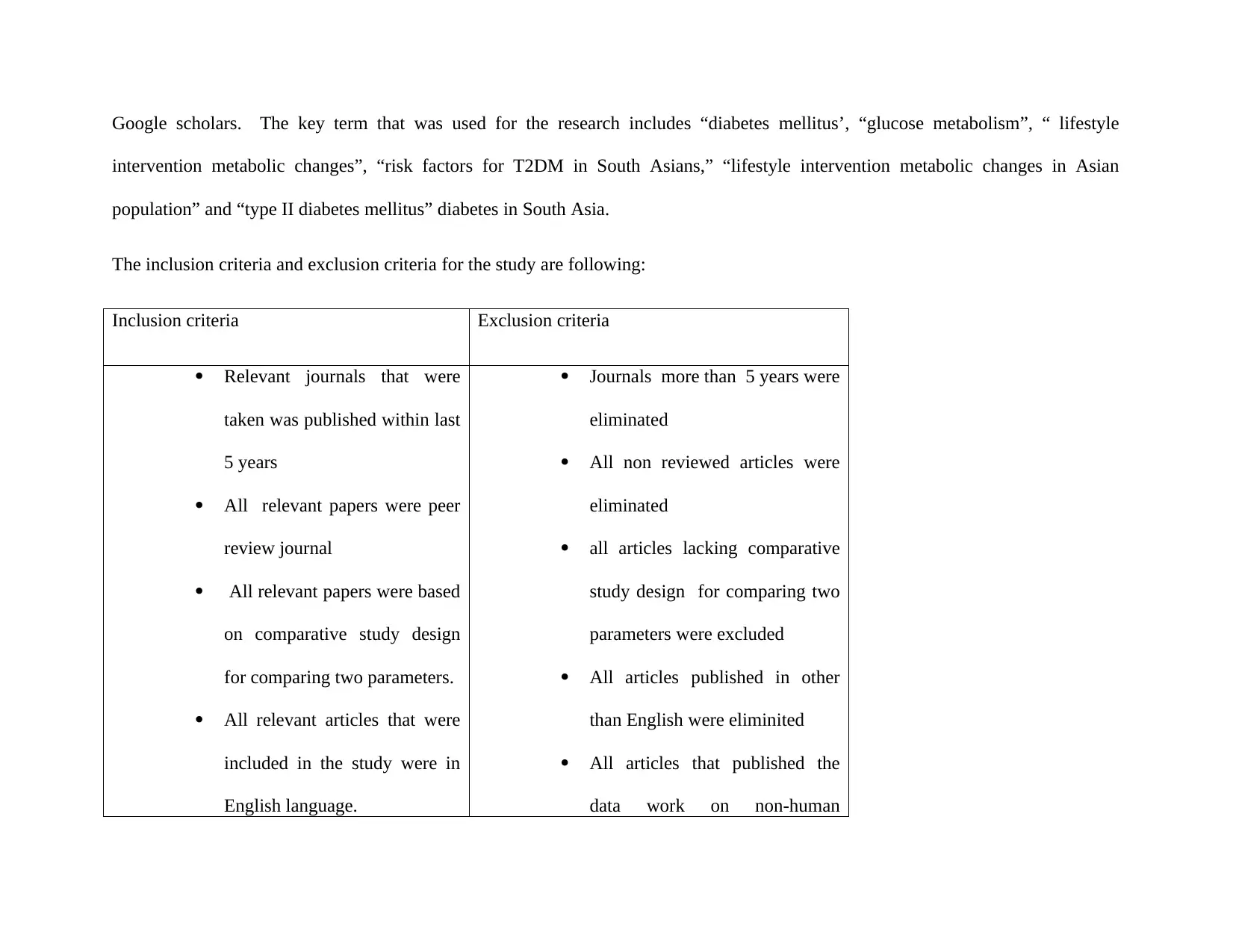
Google scholars. The key term that was used for the research includes “diabetes mellitus’, “glucose metabolism”, “ lifestyle
intervention metabolic changes”, “risk factors for T2DM in South Asians,” “lifestyle intervention metabolic changes in Asian
population” and “type II diabetes mellitus” diabetes in South Asia.
The inclusion criteria and exclusion criteria for the study are following:
Inclusion criteria Exclusion criteria
Relevant journals that were
taken was published within last
5 years
All relevant papers were peer
review journal
All relevant papers were based
on comparative study design
for comparing two parameters.
All relevant articles that were
included in the study were in
English language.
Journals more than 5 years were
eliminated
All non reviewed articles were
eliminated
all articles lacking comparative
study design for comparing two
parameters were excluded
All articles published in other
than English were eliminited
All articles that published the
data work on non-human
intervention metabolic changes”, “risk factors for T2DM in South Asians,” “lifestyle intervention metabolic changes in Asian
population” and “type II diabetes mellitus” diabetes in South Asia.
The inclusion criteria and exclusion criteria for the study are following:
Inclusion criteria Exclusion criteria
Relevant journals that were
taken was published within last
5 years
All relevant papers were peer
review journal
All relevant papers were based
on comparative study design
for comparing two parameters.
All relevant articles that were
included in the study were in
English language.
Journals more than 5 years were
eliminated
All non reviewed articles were
eliminated
all articles lacking comparative
study design for comparing two
parameters were excluded
All articles published in other
than English were eliminited
All articles that published the
data work on non-human
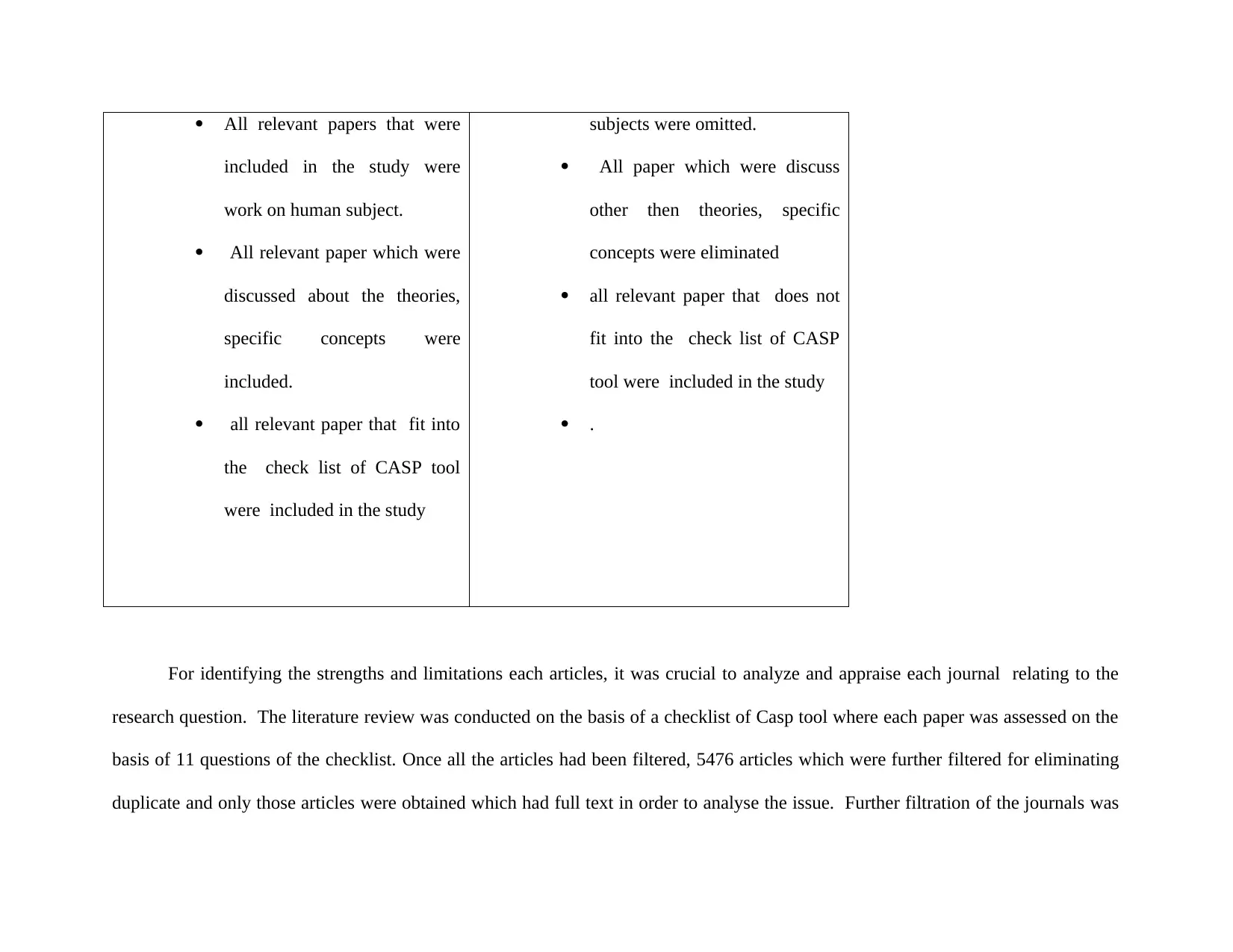
All relevant papers that were
included in the study were
work on human subject.
All relevant paper which were
discussed about the theories,
specific concepts were
included.
all relevant paper that fit into
the check list of CASP tool
were included in the study
subjects were omitted.
All paper which were discuss
other then theories, specific
concepts were eliminated
all relevant paper that does not
fit into the check list of CASP
tool were included in the study
.
For identifying the strengths and limitations each articles, it was crucial to analyze and appraise each journal relating to the
research question. The literature review was conducted on the basis of a checklist of Casp tool where each paper was assessed on the
basis of 11 questions of the checklist. Once all the articles had been filtered, 5476 articles which were further filtered for eliminating
duplicate and only those articles were obtained which had full text in order to analyse the issue. Further filtration of the journals was
included in the study were
work on human subject.
All relevant paper which were
discussed about the theories,
specific concepts were
included.
all relevant paper that fit into
the check list of CASP tool
were included in the study
subjects were omitted.
All paper which were discuss
other then theories, specific
concepts were eliminated
all relevant paper that does not
fit into the check list of CASP
tool were included in the study
.
For identifying the strengths and limitations each articles, it was crucial to analyze and appraise each journal relating to the
research question. The literature review was conducted on the basis of a checklist of Casp tool where each paper was assessed on the
basis of 11 questions of the checklist. Once all the articles had been filtered, 5476 articles which were further filtered for eliminating
duplicate and only those articles were obtained which had full text in order to analyse the issue. Further filtration of the journals was
⊘ This is a preview!⊘
Do you want full access?
Subscribe today to unlock all pages.

Trusted by 1+ million students worldwide
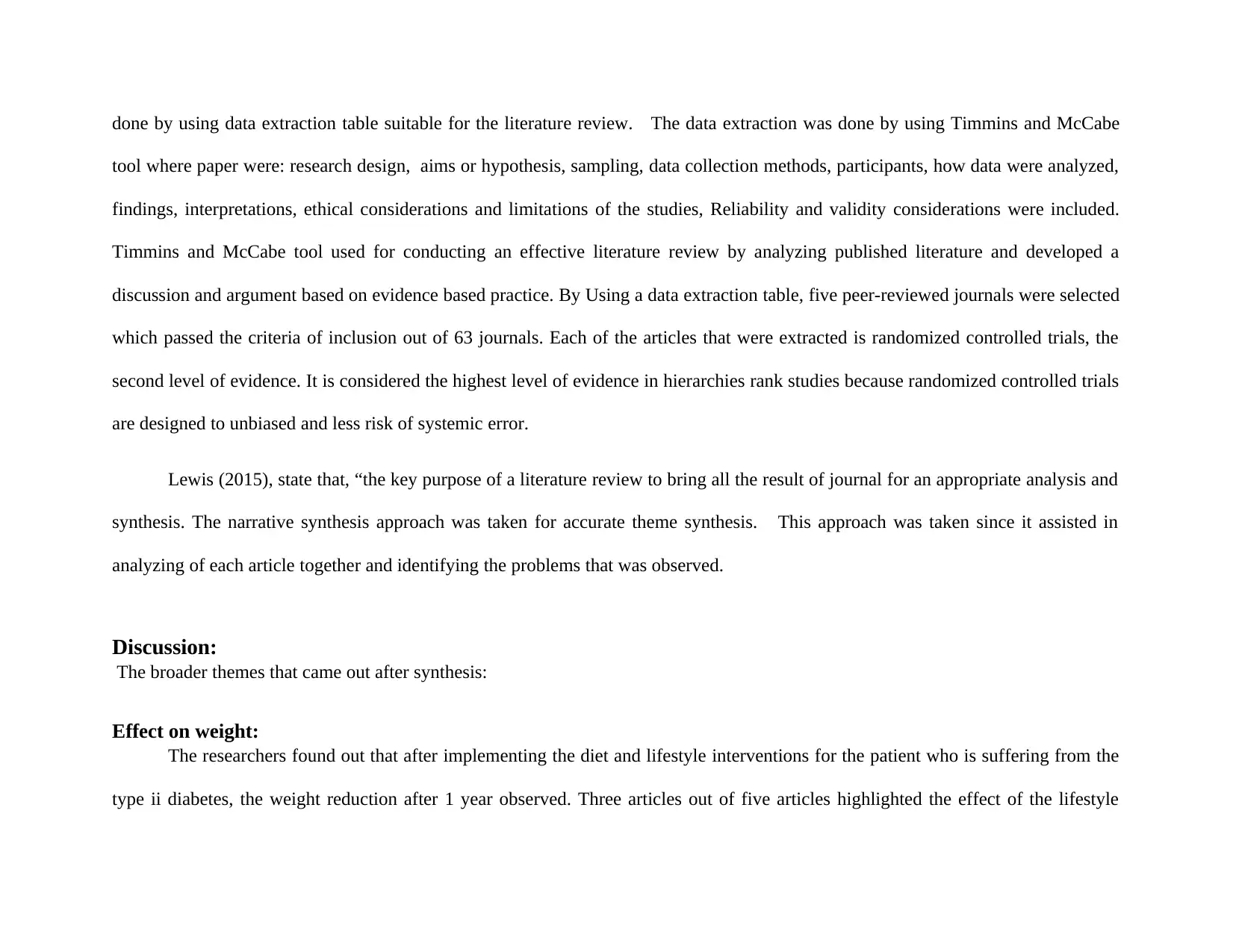
done by using data extraction table suitable for the literature review. The data extraction was done by using Timmins and McCabe
tool where paper were: research design, aims or hypothesis, sampling, data collection methods, participants, how data were analyzed,
findings, interpretations, ethical considerations and limitations of the studies, Reliability and validity considerations were included.
Timmins and McCabe tool used for conducting an effective literature review by analyzing published literature and developed a
discussion and argument based on evidence based practice. By Using a data extraction table, five peer-reviewed journals were selected
which passed the criteria of inclusion out of 63 journals. Each of the articles that were extracted is randomized controlled trials, the
second level of evidence. It is considered the highest level of evidence in hierarchies rank studies because randomized controlled trials
are designed to unbiased and less risk of systemic error.
Lewis (2015), state that, “the key purpose of a literature review to bring all the result of journal for an appropriate analysis and
synthesis. The narrative synthesis approach was taken for accurate theme synthesis. This approach was taken since it assisted in
analyzing of each article together and identifying the problems that was observed.
Discussion:
The broader themes that came out after synthesis:
Effect on weight:
The researchers found out that after implementing the diet and lifestyle interventions for the patient who is suffering from the
type ii diabetes, the weight reduction after 1 year observed. Three articles out of five articles highlighted the effect of the lifestyle
tool where paper were: research design, aims or hypothesis, sampling, data collection methods, participants, how data were analyzed,
findings, interpretations, ethical considerations and limitations of the studies, Reliability and validity considerations were included.
Timmins and McCabe tool used for conducting an effective literature review by analyzing published literature and developed a
discussion and argument based on evidence based practice. By Using a data extraction table, five peer-reviewed journals were selected
which passed the criteria of inclusion out of 63 journals. Each of the articles that were extracted is randomized controlled trials, the
second level of evidence. It is considered the highest level of evidence in hierarchies rank studies because randomized controlled trials
are designed to unbiased and less risk of systemic error.
Lewis (2015), state that, “the key purpose of a literature review to bring all the result of journal for an appropriate analysis and
synthesis. The narrative synthesis approach was taken for accurate theme synthesis. This approach was taken since it assisted in
analyzing of each article together and identifying the problems that was observed.
Discussion:
The broader themes that came out after synthesis:
Effect on weight:
The researchers found out that after implementing the diet and lifestyle interventions for the patient who is suffering from the
type ii diabetes, the weight reduction after 1 year observed. Three articles out of five articles highlighted the effect of the lifestyle
Paraphrase This Document
Need a fresh take? Get an instant paraphrase of this document with our AI Paraphraser
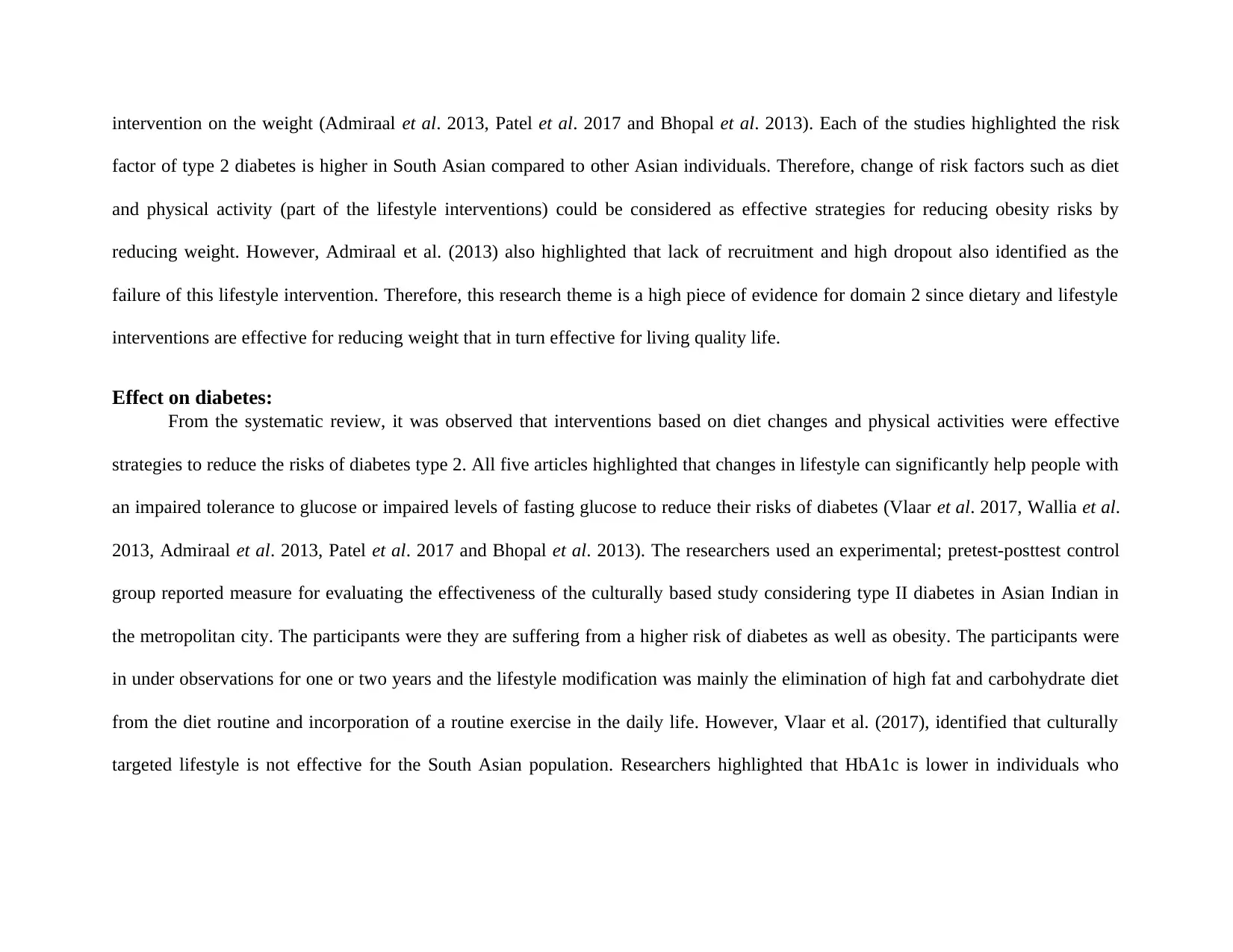
intervention on the weight (Admiraal et al. 2013, Patel et al. 2017 and Bhopal et al. 2013). Each of the studies highlighted the risk
factor of type 2 diabetes is higher in South Asian compared to other Asian individuals. Therefore, change of risk factors such as diet
and physical activity (part of the lifestyle interventions) could be considered as effective strategies for reducing obesity risks by
reducing weight. However, Admiraal et al. (2013) also highlighted that lack of recruitment and high dropout also identified as the
failure of this lifestyle intervention. Therefore, this research theme is a high piece of evidence for domain 2 since dietary and lifestyle
interventions are effective for reducing weight that in turn effective for living quality life.
Effect on diabetes:
From the systematic review, it was observed that interventions based on diet changes and physical activities were effective
strategies to reduce the risks of diabetes type 2. All five articles highlighted that changes in lifestyle can significantly help people with
an impaired tolerance to glucose or impaired levels of fasting glucose to reduce their risks of diabetes (Vlaar et al. 2017, Wallia et al.
2013, Admiraal et al. 2013, Patel et al. 2017 and Bhopal et al. 2013). The researchers used an experimental; pretest-posttest control
group reported measure for evaluating the effectiveness of the culturally based study considering type II diabetes in Asian Indian in
the metropolitan city. The participants were they are suffering from a higher risk of diabetes as well as obesity. The participants were
in under observations for one or two years and the lifestyle modification was mainly the elimination of high fat and carbohydrate diet
from the diet routine and incorporation of a routine exercise in the daily life. However, Vlaar et al. (2017), identified that culturally
targeted lifestyle is not effective for the South Asian population. Researchers highlighted that HbA1c is lower in individuals who
factor of type 2 diabetes is higher in South Asian compared to other Asian individuals. Therefore, change of risk factors such as diet
and physical activity (part of the lifestyle interventions) could be considered as effective strategies for reducing obesity risks by
reducing weight. However, Admiraal et al. (2013) also highlighted that lack of recruitment and high dropout also identified as the
failure of this lifestyle intervention. Therefore, this research theme is a high piece of evidence for domain 2 since dietary and lifestyle
interventions are effective for reducing weight that in turn effective for living quality life.
Effect on diabetes:
From the systematic review, it was observed that interventions based on diet changes and physical activities were effective
strategies to reduce the risks of diabetes type 2. All five articles highlighted that changes in lifestyle can significantly help people with
an impaired tolerance to glucose or impaired levels of fasting glucose to reduce their risks of diabetes (Vlaar et al. 2017, Wallia et al.
2013, Admiraal et al. 2013, Patel et al. 2017 and Bhopal et al. 2013). The researchers used an experimental; pretest-posttest control
group reported measure for evaluating the effectiveness of the culturally based study considering type II diabetes in Asian Indian in
the metropolitan city. The participants were they are suffering from a higher risk of diabetes as well as obesity. The participants were
in under observations for one or two years and the lifestyle modification was mainly the elimination of high fat and carbohydrate diet
from the diet routine and incorporation of a routine exercise in the daily life. However, Vlaar et al. (2017), identified that culturally
targeted lifestyle is not effective for the South Asian population. Researchers highlighted that HbA1c is lower in individuals who
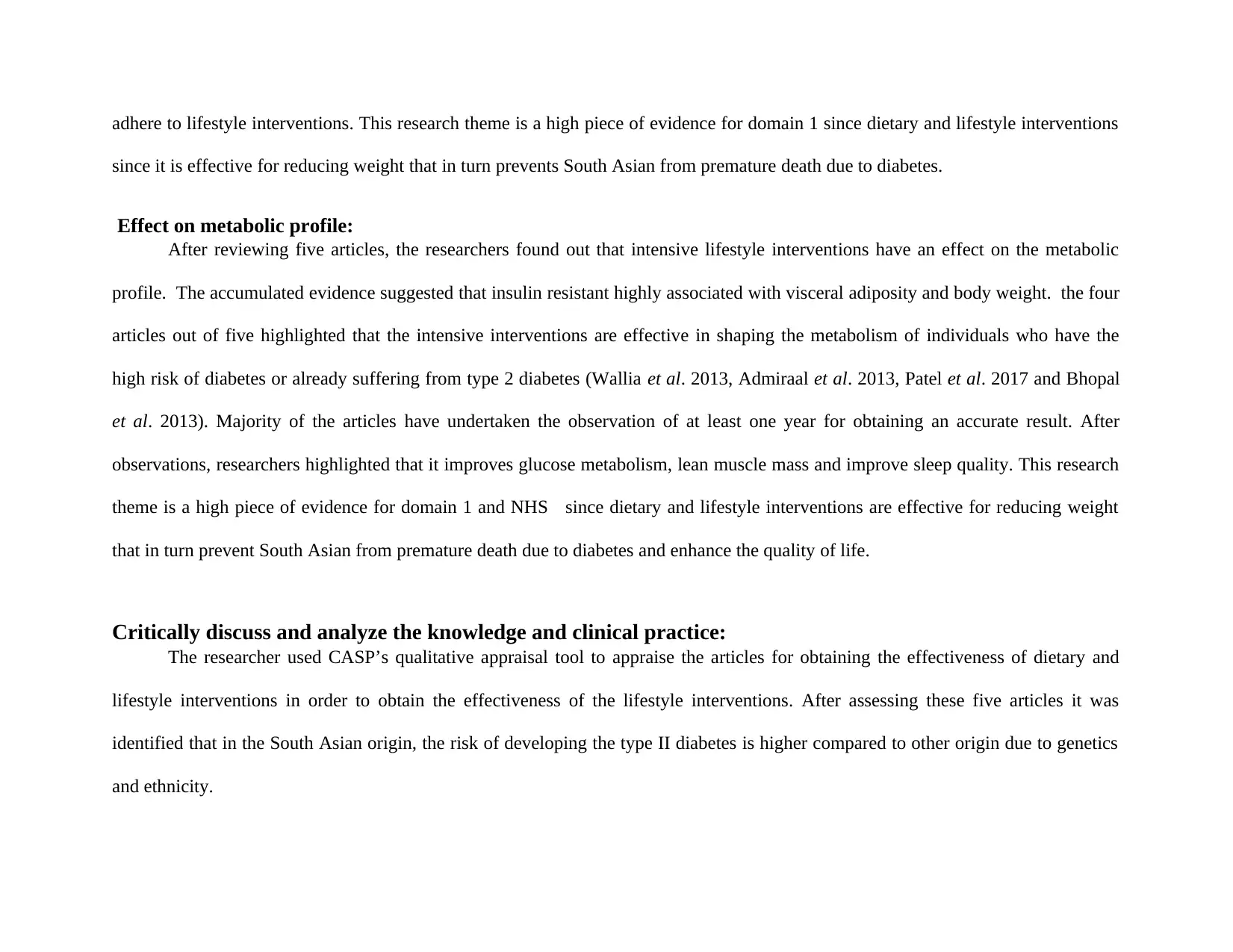
adhere to lifestyle interventions. This research theme is a high piece of evidence for domain 1 since dietary and lifestyle interventions
since it is effective for reducing weight that in turn prevents South Asian from premature death due to diabetes.
Effect on metabolic profile:
After reviewing five articles, the researchers found out that intensive lifestyle interventions have an effect on the metabolic
profile. The accumulated evidence suggested that insulin resistant highly associated with visceral adiposity and body weight. the four
articles out of five highlighted that the intensive interventions are effective in shaping the metabolism of individuals who have the
high risk of diabetes or already suffering from type 2 diabetes (Wallia et al. 2013, Admiraal et al. 2013, Patel et al. 2017 and Bhopal
et al. 2013). Majority of the articles have undertaken the observation of at least one year for obtaining an accurate result. After
observations, researchers highlighted that it improves glucose metabolism, lean muscle mass and improve sleep quality. This research
theme is a high piece of evidence for domain 1 and NHS since dietary and lifestyle interventions are effective for reducing weight
that in turn prevent South Asian from premature death due to diabetes and enhance the quality of life.
Critically discuss and analyze the knowledge and clinical practice:
The researcher used CASP’s qualitative appraisal tool to appraise the articles for obtaining the effectiveness of dietary and
lifestyle interventions in order to obtain the effectiveness of the lifestyle interventions. After assessing these five articles it was
identified that in the South Asian origin, the risk of developing the type II diabetes is higher compared to other origin due to genetics
and ethnicity.
since it is effective for reducing weight that in turn prevents South Asian from premature death due to diabetes.
Effect on metabolic profile:
After reviewing five articles, the researchers found out that intensive lifestyle interventions have an effect on the metabolic
profile. The accumulated evidence suggested that insulin resistant highly associated with visceral adiposity and body weight. the four
articles out of five highlighted that the intensive interventions are effective in shaping the metabolism of individuals who have the
high risk of diabetes or already suffering from type 2 diabetes (Wallia et al. 2013, Admiraal et al. 2013, Patel et al. 2017 and Bhopal
et al. 2013). Majority of the articles have undertaken the observation of at least one year for obtaining an accurate result. After
observations, researchers highlighted that it improves glucose metabolism, lean muscle mass and improve sleep quality. This research
theme is a high piece of evidence for domain 1 and NHS since dietary and lifestyle interventions are effective for reducing weight
that in turn prevent South Asian from premature death due to diabetes and enhance the quality of life.
Critically discuss and analyze the knowledge and clinical practice:
The researcher used CASP’s qualitative appraisal tool to appraise the articles for obtaining the effectiveness of dietary and
lifestyle interventions in order to obtain the effectiveness of the lifestyle interventions. After assessing these five articles it was
identified that in the South Asian origin, the risk of developing the type II diabetes is higher compared to other origin due to genetics
and ethnicity.
⊘ This is a preview!⊘
Do you want full access?
Subscribe today to unlock all pages.

Trusted by 1+ million students worldwide
1 out of 22
Related Documents
Your All-in-One AI-Powered Toolkit for Academic Success.
+13062052269
info@desklib.com
Available 24*7 on WhatsApp / Email
![[object Object]](/_next/static/media/star-bottom.7253800d.svg)
Unlock your academic potential
Copyright © 2020–2025 A2Z Services. All Rights Reserved. Developed and managed by ZUCOL.





